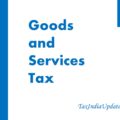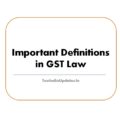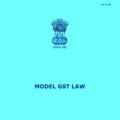GST in India: A Journey of Economic Reforms
After 17 years of continuous efforts the present Goods and Services Tax law has come into effect. The journey of GST in India was not simple unlike to other laws. There are many factors which includes political interfere, administrative control and information technology infrastructure for implementation of GST.
The long awaited economic reform the ‘Goods and Services Tax Law’ is now going to become reality as all the constitutional formalities has been finished and finally the 1st day of July, 2017 is become the day of Indian GST Law. If we look the journey of Indian GST law then we can say that the same is not simple. The following chronological order of GST Journey show that it is biggest economic reform in India after independence.
Year wise Journey of GST for Economic Reforms
| Year | Action Taken |
| 2000 | The Atal Bihari Vajpayee led NDA Government set up an empowered committee, headed by then West Bengal Finance Minister Asim Dasgupta, which was given the task of streamlining the GST model to be adopted as well as putting in place the required back end infrastructure that would be needed for its implementation. |
| 2004 | The Kelkar Task Force on the implementation of the FRBM Act, 2003 had then pointed out that although the indirect tax policy in India has been steadily progressing in the direction of VAT principle since 1986, the existing system of taxation of goods and services still suffers from many problems. The task force suggested a comprehensive Goods and Services Tax (GST) based on VAT principle. |
| 2006 | In his budget speech, then finance minister P Chidambaram announced the proposal to shift to a national taxation system. “It is my sense that there is a large consensus that the country should move towards a national level Goods and Services Tax (GST) that should be shared between the Centre and the States. I propose that we set April 1, 2010 as the date for introducing GST.” |
| 2007 | An empowered committee of state finance ministers began drawing up a road map on the legislation and in November that year, a joint working group submitted its report to the empowered committee. |
| 2008 | In April, the EC finalised its report titled “A Model and Road map for Goods and Services Tax (GST) in India” containing broad recommendations about the structure and design of GST. In response to the report, the Department of Revenue made some suggestions to be incorporated in the design and structure of proposed GST. |
| 2009 | In November, the EC, based on inputs from the Union government and states, released its First Discussion Paper on GST in India with the objective of generating a debate and obtaining inputs from all stakeholders. |
| 2010 | In his budget speech, then finance minister Pranab Mukherjee said the new legislation would come into effect from April 1, 2011. “I am confident that the government will be in a position to implement DTC (direct tax code) from April 1, 2011.” However, the UPA government failed to implement the new tax reform. |
| 2011 | In March, the Constitution 115th Amendment bill was introduced in Lok Sabha to levy GST on all goods and services except those specified. The bill was sent to the Standing Committee. |
| 2013 | The Standing Committee submitted its report to Parliament. However, the UPA government failed to win the support of BJP-ruled states including Gujarat forcing the legislation to lapse with the dissolution of the 15th Lok Sabha. |
| 2014 | The Constitution (122nd Amendment) Bill, 2014 was introduced in the Lok Sabha by Finance Minister Arun Jaitley on 19 December 2014, and passed by the House on 6 May 2015 |
| 2015 | Finance Minister Arun Jaitley announced in his budget speech 28-02-2016 that the government is keen on implementing the GST by April 1, 2016 and hoped that the bill will be cleared by Parliament. In the on-going Monsoon Session, the government is hopeful of passing the bill in Rajya Sabha, where it lacks a majority, with the support of regional parties. |
| 2016 | The bill was passed by the Rajya Sabha on 3 August 2016, and the amended bill was passed by the Lok Sabha on 8 August 2016.
In September 2016 Hon’ble President Pranab Mukherjee gives assent to the Bill. Shri Mukherjee forms GST Council to frame separate GST Bills. |
| 2017 | The efforts of PM Modi led Government get success in March 2017: Four Key GST Bills — Central GST (CGST), Integrated GST (IGST), State GST (SGST) and Union Territory GST (UTGST) — passed by Lok Sabha and Rajya Sabha.
In May 2017: GST Council unveils four slab-rates for GST regimes. rates fixed at 5, 12, 18 and 28%. Over 80% of goods of mass consumption either exempted or taxed under 5% slab. |
The Goods and Service Tax is being rated as the most reformative measure proposed in the field of Indirect Taxation in the history of India. It is expectation from new system of Indirect Taxation that it would remove cascading effect of taxes resulting in cutting in cost of industrial products. The cumulative effect of GST would clear the path for transparent Tax Administration in our country.
This is all about journey of GST in India. So let us know what is your view on GST road map from starting to present position. Comment below and express your view………….
- Whether this reform is on time or we are late.
- Whether expectation of assessee and Government will fulfill.
- Whether still political interfere would cause in proper implementation of GST.





THANKS